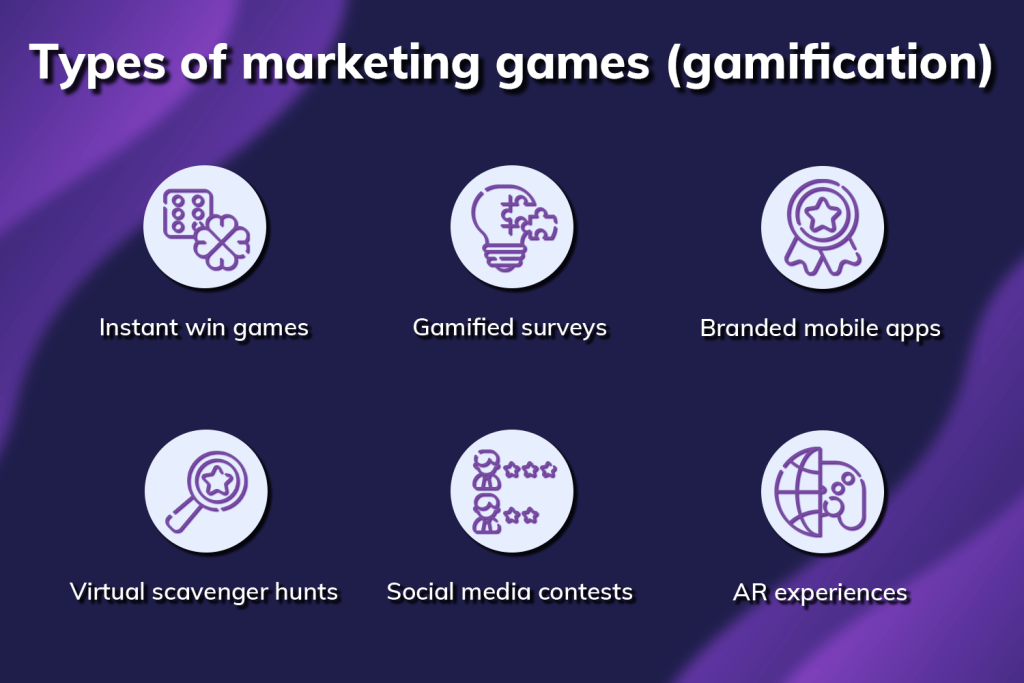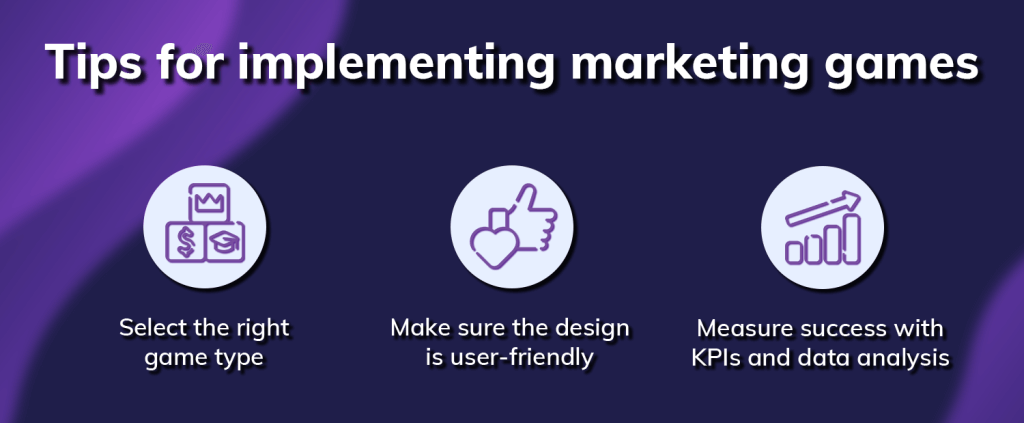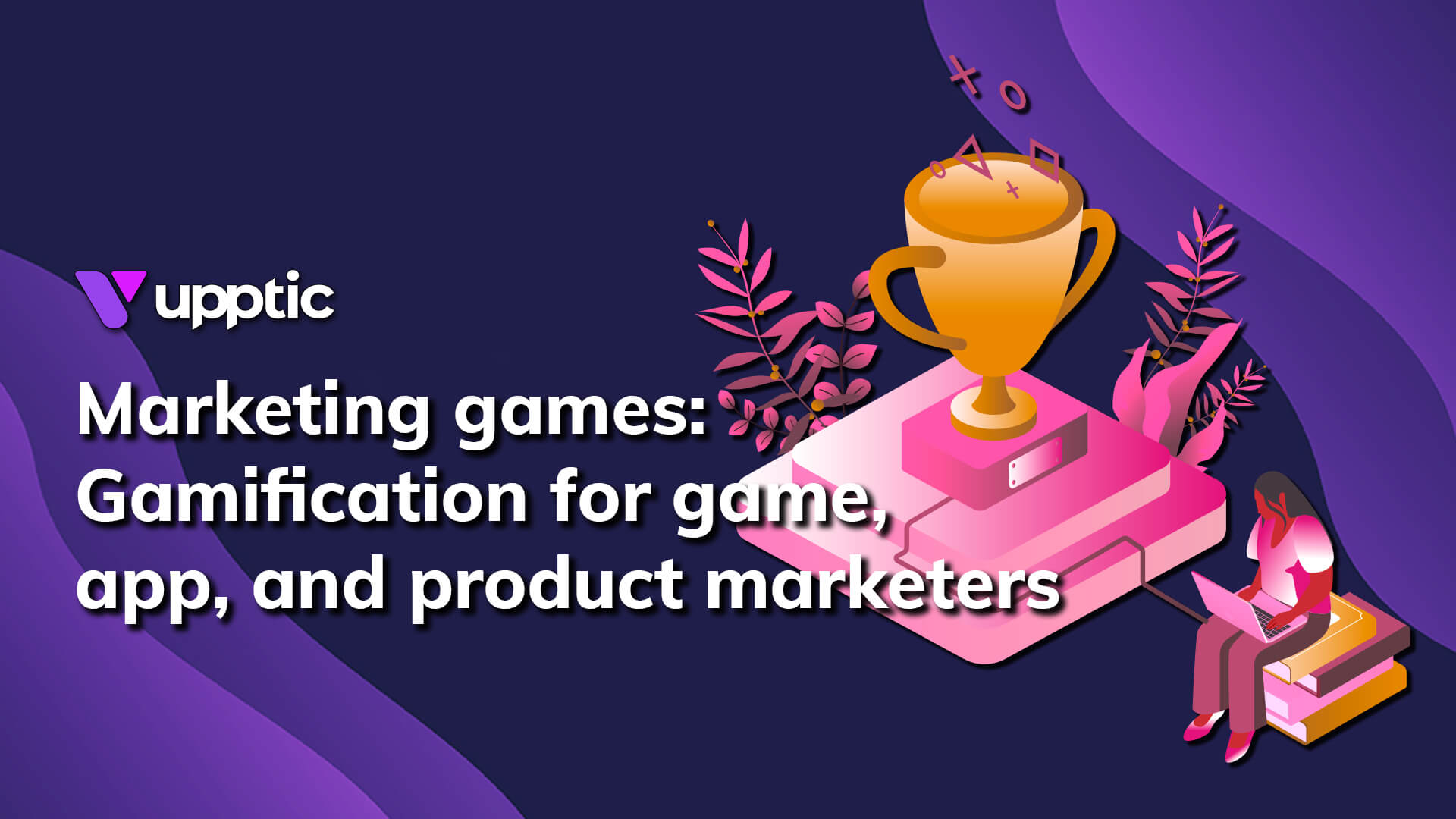“Marketing games” is such an ambiguous term. It can refer to the games used as marketing tools to engage with customers and boost sales (i.e. gamification), or it can refer to the marketing of mobile and video games to potential players.
This article aims to fill the gap between both and provide something for everyone. Whether you are marketing games, software, physical products, or services, use it to help you build your own great gamification strategies.
For those of you who are game marketers, we highly encourage you to read our article on growth marketing techniques for games – which goes into far more depth on games marketing – or reach out to us directly. We love hearing from game developers of all sizes!
Use the chapter selector below to jump to a chapter.
- The power of marketing games
- Six game ideas to elevate your marketing strategy
- Tips for implementing marketing games successfully
- Key takeaways
The power of marketing games
Marketing games can be transformative in driving customer engagement, sales leads, player retention, game installs, and more. A strategic blend of fun and promotion, marketing games not only captivate audiences but also foster lasting brand connections.
What is it about marketing games that make them an impactful asset for businesses? First and foremost, they amplify engagement considerably. By transforming typical marketing content into a fun game, you can captivate your audience’s attention, encouraging them to interact more with your brand.
Furthermore, these games can significantly improve conversion rates, game installs, and player retention. As customers or players become more engaged with your brand, they are more likely to take desired actions, such as making a purchase or signing up for your newsletter.
The psychology behind gaming
But why are people so captivated by playing games? Understanding the psychology behind gaming can help us realize why marketing games are such an effective tool for capturing customer attention and driving desired behaviors. Games tap into our innate human desires for competition, achievement, and social interaction.
When we enter a state of flow in gaming, where our skills and challenges are well matched, we experience various psychological rewards such as rapid growth, speed, and reward. This exhilarating experience is what makes games so enjoyable, and why they can be such a powerful tool in marketing.
In fact, the purpose of building social games in a content marketing strategy is to craft content that is not only enjoyable but also shareable, thus expanding the reach of your brand.
Six game ideas to elevate your marketing strategy
So how can you go about incorporating gamification into your marketing strategy to give it a significant lift? There are multiple options available! You may decide that only one fits for your company – or maybe they all do. These include:

- Instant win games
- Gamified surveys
- Branded mobile apps
- Virtual scavenger hunts
- Interactive social media contests
- Augmented reality experiences
Each of these game ideas offers a unique approach to customer engagement and player interaction. By implementing one or more of these game ideas into your marketing strategy, you can significantly boost your brand exposure, drive sales or game installs, and create a more engaging and interactive experience for your customers or players.
Instant win games
Instant win games are games that don’t require waiting until the end of a promotional period before winners are drawn. The key to a good instant win game is to ensure it’s easy to engage with and the rules are simple. Keep any data collection forms short and sweet and do the same with the rules, while making sure they are easy to find.
Instant win games are a fantastic way to:
- Engage customers and players
- Increase the time they spend with your brand
- Gather customer leads or increase player retention
With such games, the goal is not only to entertain but also to engage customers or players in a meaningful way, driving brand awareness, and generating valuable user data. This not only boosts sales but also contributes to higher engagement and conversion rates.
Gamified surveys
Surveys are a great way to collect valuable customer or gamer insights, but let’s face it – they can sometimes be a bit boring. Gamified surveys turn this around by transforming the survey-taking process into an enjoyable and engaging experience.
 Gamified surveys, with their integration of game elements and techniques, strive to enhance response rates and gather superior quality data. Better questions, improved engagement, and fun interactions make these surveys a game-changer in marketing research.
Gamified surveys, with their integration of game elements and techniques, strive to enhance response rates and gather superior quality data. Better questions, improved engagement, and fun interactions make these surveys a game-changer in marketing research.
Moreover, by offering rewards and creating an enjoyable, interactive experience, customers and players are motivated to provide more accurate and honest feedback, leading to deeper insights into their preferences and behavior patterns.
You can gamify your surveys with the following:
- Jump logics: Allow people to choose where to go next in the survey, or use their answers to adjust the flow of the survey in personalized ways.
- Make it a competition: Give scores, provide leaderboards, and/or provide badges and rewards. These things take a survey from mundane into an engaging social activity.
- Gamify questions: Instead of straightforward boring questions like “What is your favorite game?” make the questions more like a fun quiz – such as “If you could live in any game world, which one would it be?” Even better if the end result gives them something like a personality quiz would.
Branded mobile apps
Branded mobile apps offer an immersive platform for demonstrating your products, services, or games, all the while providing entertainment and incentives for users.
 By including the following features, you can create an impactful branded mobile app that significantly boosts customer or player engagement:
By including the following features, you can create an impactful branded mobile app that significantly boosts customer or player engagement:
- Rich push notifications: Send notifications that highlight updates, offers, and features that users will actually appreciate and want.
- User-friendly interface: Use clean design, provide light and dark themes, ensure menus are easily navigable, and provide accessibility options.
- Social media integration: Provide integration with social media platforms and make it easy for users to share items of interest and achievements with their networks.
- Personalization: Use your customer’s or player’s name and avatar prominently within the app and curate content based on the their preferences and wants.
A successful app can set your brand apart, leaving a lasting impression on consumers and gamers – enhancing your brand’s reputation.
Virtual scavenger hunts
Virtual scavenger hunts represent yet another inventive gaming concept that could turbocharge your marketing tactics. These online marketing games create excitement and competition as participants search for specific items or complete tasks based on a provided list.
Steps for creating an effective scavenger hunt include:
- Brainstorming scavenger hunt ideas: Think about things that are accessible and relevant for your audience.
- Choosing the day and time: Consider times when your target audience might be free or around a particular area.
- Establishing the rules: Make sure they are fair and easily accessible.
- Setting a time limit: Creating a short window can create some FOMO (fear of missing out) and can actually lead to more engagement than a longer window would.
- Awarding prizes: Make sure they are compelling, relevant to your audience, and known beforehand.
Potential virtual scavenger hunt items could include pictures or video of:
- Favorite items
- Pets and animals
- TikTok trends
- Landscapes
- Office supplies
- Home furnishings
- Foods and drinks
- Vehicles
If the virtual scavenger hunt is taking place within your game, consider having players capture:
- Game characters
- Maps, tools, menus
- Items, weapons, accessories
- Special locations or areas
Not only do these hunts provide a fun and engaging experience for customers and players, but they also encourage teamwork and communication, increase brand awareness, and provide valuable data insights. Plus, with the help of technology, you can make these hunts more engaging for mobile users by using QR codes, incorporating augmented reality technology, and utilizing dedicated scavenger hunt apps.
Interactive social media contests
Interactive social media contests serve as another great method for amplifying customer or player engagement and enhancing brand visibility within an online marketing campaign. These contests encourage user-generated content and social sharing, exposing your brand to a larger audience.
To create captivating contests, you can implement creative concepts such as:
- Discovery games: These games are a cross between a treasure hunt and team competition. Perfect for students, work teams, game guilds, etc.
- Design contests: If your company is looking for ideas for a new logo, jingle, game character, game item, etc., your audience may have just what you need. Design contests make your customers or players an active part of your company’s or game’s brand. However, these can occasionally be a double-edged sword. Younger generations, especially, are starting to view these types of contests as a way to get “free work” from people – which can make them think twice about engaging with your company.
- User-generated content challenges: Most everyone loves to be part of a community and to feel appreciated for their contributions. Encouraging and highlighting fan art, fan fiction, and other ways that fans show their love for your brand or game is a win-win for everyone.
- Identity quizzes: Also known as personality tests, identity quizzes are a great way to make people feel both individually special and a part of a special group – and it can be a great source of customer and player data as well.
These contests not only boost engagement but also amplify brand buzz, attracting a larger audience to your brand’s social media platforms.
Augmented reality experiences
Lastly, we turn our attention to augmented reality, or AR, experiences. They provide one-of-a-kind, immersive interactions that bolster customer or gamer engagement and propel sales or player retention. Augmented reality overlays digital content onto real-life environments and objects, creating a dynamic and immersive experience.
Steps to consider for augmented reality experiences include:
- Defining your objectives: Is the purpose of your AR experience for brand awareness, game installs, player retention, or something else? The goal of your AR experience while define the people you will target and how the AR experience plays out.
- Knowing your users: For AR experiences, it’s important to know where your audience is and when, what they are into, what their motivations are, and potential pain points they might experience.
- Designing for interaction: AR experiences are meant to meld the virtual and physical worlds. Make sure to make the most of this – and make sure the user-interface is intuitive as well.
- Balancing realism and creativity: AR can let imagination take flight, but it’s good to keep the AR aspects grounded in realistic lighting, properly scaled models, realistic positioning, and so on.
- Optimizing for performance: Make sure to test your AR experience thoroughly on all the different devices you plan to make it available on – this way you can catch issues and bugs early, and ensure that your users ultimately have a smooth and enjoyable experience.
This cutting-edge technology has the potential to revolutionize your marketing strategy, providing an innovative way to showcase your products, engage your customers or players, and stand out from the competition. If you’re looking to push the boundaries of what’s possible in marketing, augmented reality might be the answer.
Tips for implementing marketing games successfully
Having amassed a plethora of inventive marketing game ideas, how should you go about executing them effectively? Here are some tips to help you get the most out of your marketing games.

Selecting the right game type
The selection of an appropriate game type is key to making sure your marketing game strikes a chord with your target demographic. To do this, you need to understand your audience’s demographic information, interests, and habits. Understanding their preferences will guide you in identifying the game type that will be most appealing to them.
 From games of chance to knowledge games and immersive games, there’s a game for every preference and interest. By aligning the game mechanics with your brand and making it relevant and enjoyable for your target audience, you can create a marketing game that truly hits the mark.
From games of chance to knowledge games and immersive games, there’s a game for every preference and interest. By aligning the game mechanics with your brand and making it relevant and enjoyable for your target audience, you can create a marketing game that truly hits the mark.
Ensuring user-friendly design
One of the fundamental principles of successful marketing games is incorporating game elements that assure a user-friendly design. This means creating a game that is intuitive, visually appealing, and accessible to all users, including those with disabilities.
By choosing vibrant and eye-catching color palettes, keeping designs simple and uncluttered, and ensuring consistency in style and theme, you can create a visually stunning game that captivates your audience. Furthermore, incorporating non-visual cues such as sound and haptic feedback can ensure accessibility for disabled players, making your game inclusive and enjoyable for everyone.
Measuring Success
Finally, evaluating the success of your marketing game is vital for comprehending its influence and efficacy. To do this, you should track key performance indicators (KPIs) like engagement rates, conversion rates, game installs, player lifetime value (LTV), and overall return on investment (ROI).
By gauging user interaction and identifying areas for improvement, you can optimize your game and ensure you’re getting the most out of your marketing strategy. Moreover, by measuring the share of players who complete a desired action, you can track conversion rates and understand the effectiveness of your game in driving desired outcomes.
Key takeaways
Marketing games provide an innovative and effective way to engage customers and players, boost brand awareness, and drive sales, game installs, or in-app purchases.
Whether it’s through instant win games, gamified surveys, branded mobile apps, virtual scavenger hunts, interactive social media contests, or augmented reality experiences, these games offer unique opportunities to connect with your audience and elevate your marketing strategy.
The key is to know your audience, build a compelling and accessible marketing game, and measure and optimize it for the most success.
And if you need help taking your game’s marketing to the next level, we can help.

